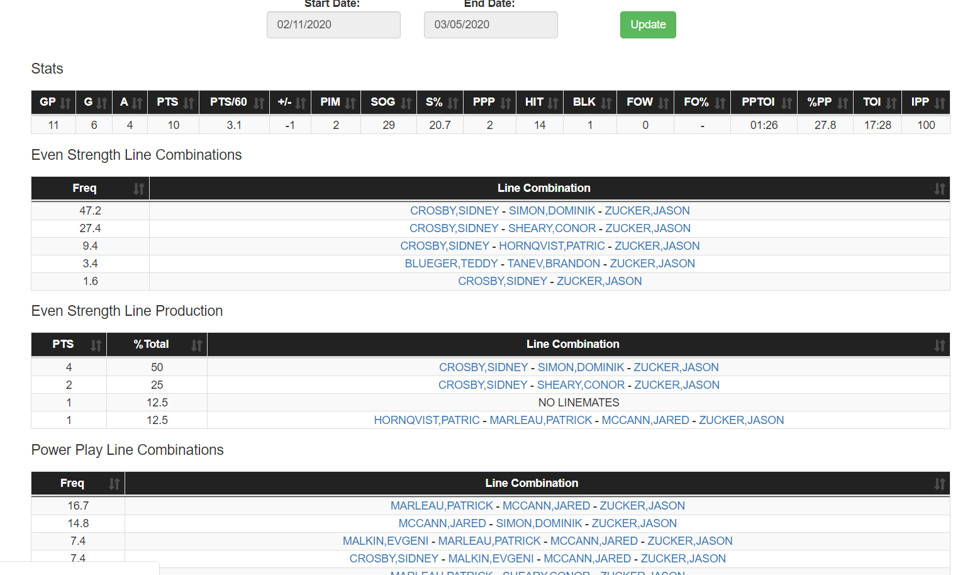The trade deadline is often the fastest way to change a player's ownership percentage in fantasy. We see a news story flashing some hype, and get excited about the prospect of that player's new deployment situation. Sometimes the change is worth it, sometimes not. This week we are going to use a handy Dobber tool to take a look at a few of the players who moved around at the deadline and see what has changed.
First up, let's examine the tool. On a player's profile page there is a tab for Player Calculator. This tool allows you to select a beginning date and an end date and returns a great series of data to show what that player has been doing over that time period. We can also use that tool to do a pre and post examination. We start with what a player has been doing since the trade deadline and compare that to what they were doing prior. For our first example let's take a look at Jason Zucker.
Zucker was traded from Minnesota to Pittsburg on Monday, February 10th. If we enter the 11th into the calculator we get a return that shows all of his recent stats, as well as his line combinations.

A couple of things stand out here. Zucker is scoring at almost a point per game since the trade, shooting almost three times per game, spending almost all of his time with Sidney Crosby at even strength, and his IPP is at 100 percent.
To make our comparison we can pull the top stat line from this report and run a second report for the 11 games (about a month) prior to the trade from Minnesota.
Pittsburgh:

Minnesota:

Just about everything is different here. The only thing that is close is the amount of power-play time (which isn't high). Other than that Zucker has gained three minutes in overall ice time, has doubled his shot pace, and doubled his point pace. These things are all definitely connected. His Pittsburgh point pace is definitely helped by his unsustainable 100 percent IPP, but even if that regresses it looks like Pittsburgh is offering him a much better deployment situation than he was getting in Minnesota.
Part of the benefit is, of course, getting to play with a superstar like Crosby, but sometimes these trades don't always work out like advertised. For that, let's jump to Edmonton.
Ennis was traded from Ottowa to Edmonton on February 24th. Granted that means we have a bit of a smaller sample size, but let's take a look at what has taken place so far.
Edmonton:

During his time in Edmonton, Ennis has seen upwards of 85 percent of his even-strength time on ice with Connor McDavid. His three points in five games is not all that encouraging, but if he sticks with McDavid long enough things are bound to happen right?
Ottawa:

If we compare his time in Edmonton to a similar number of games in Ottawa we see some decidedly mixed results. Ennis' power-play time has cratered since moving to Edmonton, but his overall time has increased by about a minute. His shot rate has dipped, but he is scoring at a similar (and not very relevant) pace. One positive note is that his scoring pace in Ottawa included a 100 percent IPP which was not sustainable, whereas his pace if Edmonton has a better chance to be.
One other potential downfall for Ennis in Edmonton is that they definitely do not need him to score. Their offense runs through McDavid and Leon Draisaitl. If Ennis gets bumped off of that line his value is absolutely zero. At least in Ottawa, he had the potential to play a bit more as they had very few offensive weapons to utilize over him.
Concerns about deployment, bring us to a second Edmonton trade-line acquisition deal.
Like Ennis, Athanasiou was acquired by Edmonton on February 24th. Initially, it looked like he was going to be in line for some prime deployment. His first couple of games in Edmonton he was lining up with McDavid and Ennis. In fact, some 55 percent of his even-strength shifts over these five games are with McDavid. Unfortunately, the experiment was short-lived. His most recent linemates have been Zach Kassian and Riley Sheahan.
Given all of that let's compare his short stint in Edmonton to a similar amount of games in Detroit.
Edmonton:

Detroit:

Right off the bat, I am seeing a two-minute drop in ice time, almost all of it on the power-play. That is certainly not what anyone jumping on Athanasiou out of the trade deadline was hoping for. His shot pace also dropped to below two shots per game over this short period. Given the short sample sizes, we haven't seen a huge dip in point production, but it is not encouraging that his two points in Edmonton have come with a 100 percent IPP.
Ilya Kovalchuk:
Last, but not least Kovalchuk was traded from Montreal to Washington on February 23rd. Kovalchuk had been a bit of a revelation since joining Montreal, going on several short runs of solid production. In Washington, he is spending most of his time on the third line with Lars Eller, and Carl Hagelin though has been getting some turns on the power-play.
Washington:

Again we have another example of a player scoring limited points in a new role, but having an IPP of 100% (that wasn't the criteria for this article, promise).
Montreal:

When we compare to his stats from Montreal we see that moving to Washington has decreased his total time on ice just over a minute. His shot pace is down fairly dramatically as well. He is getting about the same percentage of his team's power-play though that has resulted in more power-play time on ice so far in Washington. His role has definitely shifted from a top-six winger to a third-line potentially power-play specialist.
These samplings demonstrate a pretty clear dichotomy here. Expectations for player performance are very dependent on the role they land in their new location. In many cases, the player moving from a selling team to a buying team is going to see a reduced role (time on ice, power-play time, quality of linemates). This makes sense as most buying teams are rounding out their depth and most selling teams are utilizing these players as key pieces. The exception seems to be in cases like Zucker (or potentially Ennis) where the 'depth' role that needs filling is right next to a superstar. These things are notoriously difficult to predict (see Athanasiou), but those who managed to jump on the right player (Zucker in this case) are certainly reaping the rewards.
Until next week, thanks for reading.
Want more tool talk? Check out these recent Frozen Tool Forensics Posts.





 FLA
FLA CHI
CHI NYR
NYR PIT
PIT L.A
L.A COL
COL UTA
UTA BOS
BOS BUF
BUF SEA
SEA NYI
NYI VAN
VAN DET
DET MIN
MIN ARI
ARI
